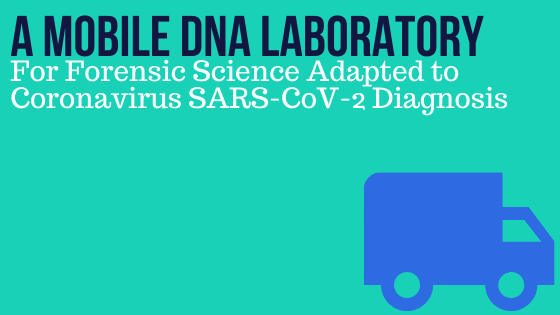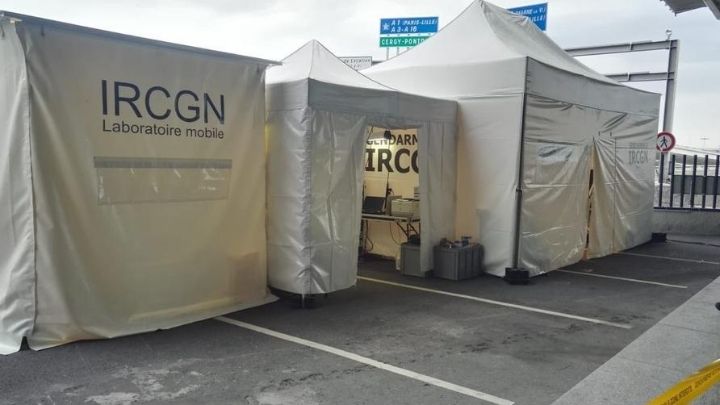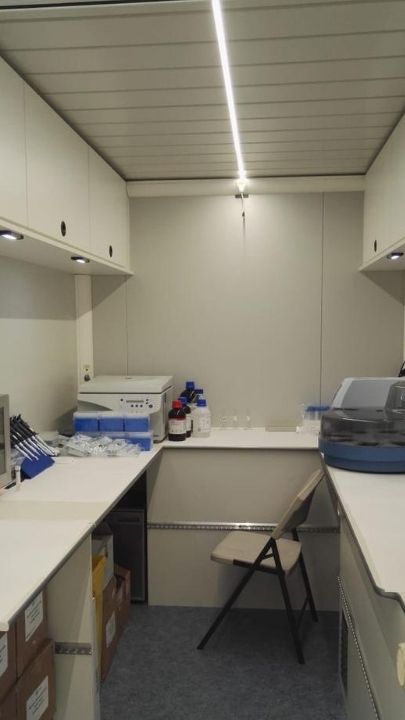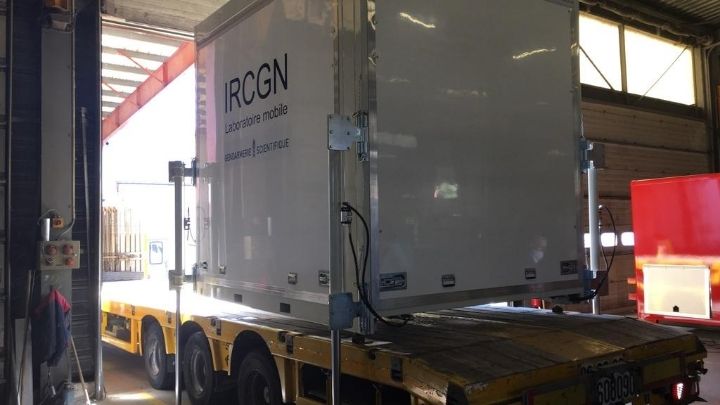When we last interviewed Sylvain Hubac he explained how the mobile DNA lab he helped design for the French Gendarmerie (IRCGN) has been used to facilitate DNA identification in various settings. What exactly is the mobile DNA Lab and why is it more useful than employing standard practices for processing DNA?
Hubac and colleagues envisioned creating a lab on wheels stocked with the specialized equipment needed to quickly process DNA samples. Some areas of the country lack the specialized equipment and reagents that are necessary to process DNA samples in an expedited timeframe. The lab that Hubac conceived would be able to travel to remote locations where modern forensic laboratory facilities might not be available. Once on location, the scientists deployed with the lab could collect the required samples and process evidence on site.
Several issues needed to be considered when designing the mobile lab. Crime labs are specially designed to separate pre and post amplification processes. Care must be taken to avoid contamination between the two environments. Reagents and samples need to be stored under refrigeration and the equipment needs a power supply. Therefore, the lab would also need to have a self-contained power supply that could generate sufficient current and operate for extended periods of time. After a great investment of time and money, the first mobile lab was ready to be deployed.
Shortly after the first mobile lab was finished, it was subjected to its first big test. A terrorist attacked a group of celebrants on Bastille Day in Nice, France. More than 80 people were killed in the attack when a fanatic driving a truck purposely drove at high speed through a crowd celebrating the holiday. Many of the victims were tourists on holiday. Speedy identification of the bodies was essential to allow families to be notified and the remains returned.
Within hours of the terrorist attack, the mobile lab was on its way to the scene. Within the span of only a few days all the victims were identified demonstrating the efficiency of bringing a forensic lab directly to the crime scene.
Recently Sylvain and colleagues wondered if the Mobil’DNA unit could serve another purpose. With the COVID-19 pandemic raging, they suggested deploying the lab to assist in processing samples from the potentially infected. To date the Mobil’DNA unit has assisted with more than 12,000 COVID samples.
We caught up with Sylvain and asked him about the IRCGN deployment of their mobile DNA unit to assist with testing in the pandemic.
Can you describe some of the challenges you had to overcome to repurpose the mobile unit to process COVID samples instead of standard DNA samples?
We had to overcome two major challenges:
- the time because we have validated the workflow in only few days following ISO 15189 and ISO 17025 procedures
- the training of more than 40 technicians in order to ensure the capability to process samples 7 days on 7 during 3 months
I assume that special precautions needed to be taken to ensure that samples were safely collected. Who was tasked with collecting the samples and what steps were taken to ensure the safety of personnel?
The samples were collected by nurses or medical doctors specially trained for nasopharyngeal collection using a swab.
When you have to deal all the days with forensic samples for DNA analysis you need to use very strict SOP process to prevent contaminations of samples. So we just applied this same rigorous process for COVID Samples unlike in sampling practice where we worked under a microbiological safety cabinet to protect the operator from the samples and inactivate the virus. For this step the technicians wearing full suits, gloves, safety glasses and FFP2 mask.
How quickly were results generated with the mobile lab? How many samples did you process?
The results of 96 samples were generated in less than 4 hours using an automated process involving only 5 technicians. We processed more than 12000 samples with a maximum capability of 1000 samples per day.
The Mobil’DNA lab of the French gendarmerie was adapted as a true extension of the fixed hospital laboratory by validating the following analytical process in 5 steps:
- Taking samples and recording into the LIMS of the Mobil’DNA lab for traceability on the basis of the unique barcode identifier. This LIMS is connected to the LIMS of the hospital unit in order to transfer automatically the results of the essays and provide the clinical microbiologist with a complete overview and control of analytical data.
- Sampling a fraction of the biological sample to be analysed. This operation is carried out under a type 2 microbiological safety cabinet (MSC) requalified on the site. This operation is carried out from a 96-position DeepWell type plate, using an innovative samples positioning system (SPS) patented by the IRCGN in a modular version allowing its use under the MSC (Carol I can provide you some pictures of the SPS if you want)
- Extraction of the RNA contained in the sample by lysis of the virus using chemical agents (Viral prep Adem-kit®, Ademtech France) followed by magnetic beads purification using KingFisher Flex® Apex instrument (ThermoFisher) allowing 96 purification in 40 minutes. .
- Quantification of purified RNA by real-time PCR (RT-PCR) system. The RT-PCR is performed in 80 minutes with the GeneFirst RUO COVD-19 Detection Kit (CE-IVD pending) validated by the French National Reference Center for respiratory viruses, Pasteur Institute. The protocol is performed according to the recommendation of the manufacturer. The reverse transcription reagents for the RNA virus are done in one shot in the sample with the same reagents. This kit allows detection of two specific targets of COVID-19 (NGene and ORF1 ab) and one internal control human target (GAPDH) (19).
- Results interpretation and generation of reports. This operation is carried out using an in house software GendLink® adapted to the occasion to generate a report on the results of COVID analyses.
What were the benefits of deploying the mobile lab versus requiring patients to travel to a health facility? What are other scenarios where a mobile lab would help with rapid DNA analysis?
The Mobil’DNA lab and the forensic science laboratory of the French gendarmerie in the context of the COVID-19 pandemic provided three short-term issues with a direct impact on this crisis situation:
- The possibility within a short time of setting up an additional testing capacity to deal with a massive influx of individuals to be tested on a hospital site. This makes it possible to limit the bottlenecks in hospital services in the event of urgent results being needed during the phases of the rise of the pandemic, and, at the time of deconfinement, by moving autonomous test capacities in a planned manner. The laboratory is 100% autonomous, and capable of handling the process from the sample to the rendering of results. One of the interests resides besides in this exit from the confinement, where one will be in working order to detect well those which become positive, and thus to separate them from those which would remain negative in order to avoid the famous second wave, main concern of the exit from this confinement. Indeed, we will never have this type of information through serology, which only indicates it if a patient has been in contact with the virus, but not if he is infectious or not.
- Respond to a demand for test capacity in rural areas or overseas, for citizens distant from the test centres, or even in the absence of these. This will limit mass movements to test centres and provide an immediate solution. Once validated, the concept will be very easily transposable for other situations, and will be deployed in record time, anywhere in France, including overseas.
- Validate and propose to other countries a global and efficient concept of mobile lab unit for rapid molecular diagnostic tests, easily transposable and deployable anywhere in the world during such a scenario combining expertise of interior security force with high throughput Forensic DNA capabilities and expertise of clinical microbiology structure in the diagnosis of endemic pathogens.
The other scenarios where a mobile lab would help with rapid DNA analysis are cross border control, or massive DVI context where the shortest time to identify the victims is crucial for the family and the logistic for manage humans remains from the crime scene to the regular laboratory is very restrictive.
WOULD YOU LIKE TO SEE MORE ARTICLES LIKE THIS? SUBSCRIBE TO THE ISHI BLOG BELOW!
SUBSCRIBE NOW!





